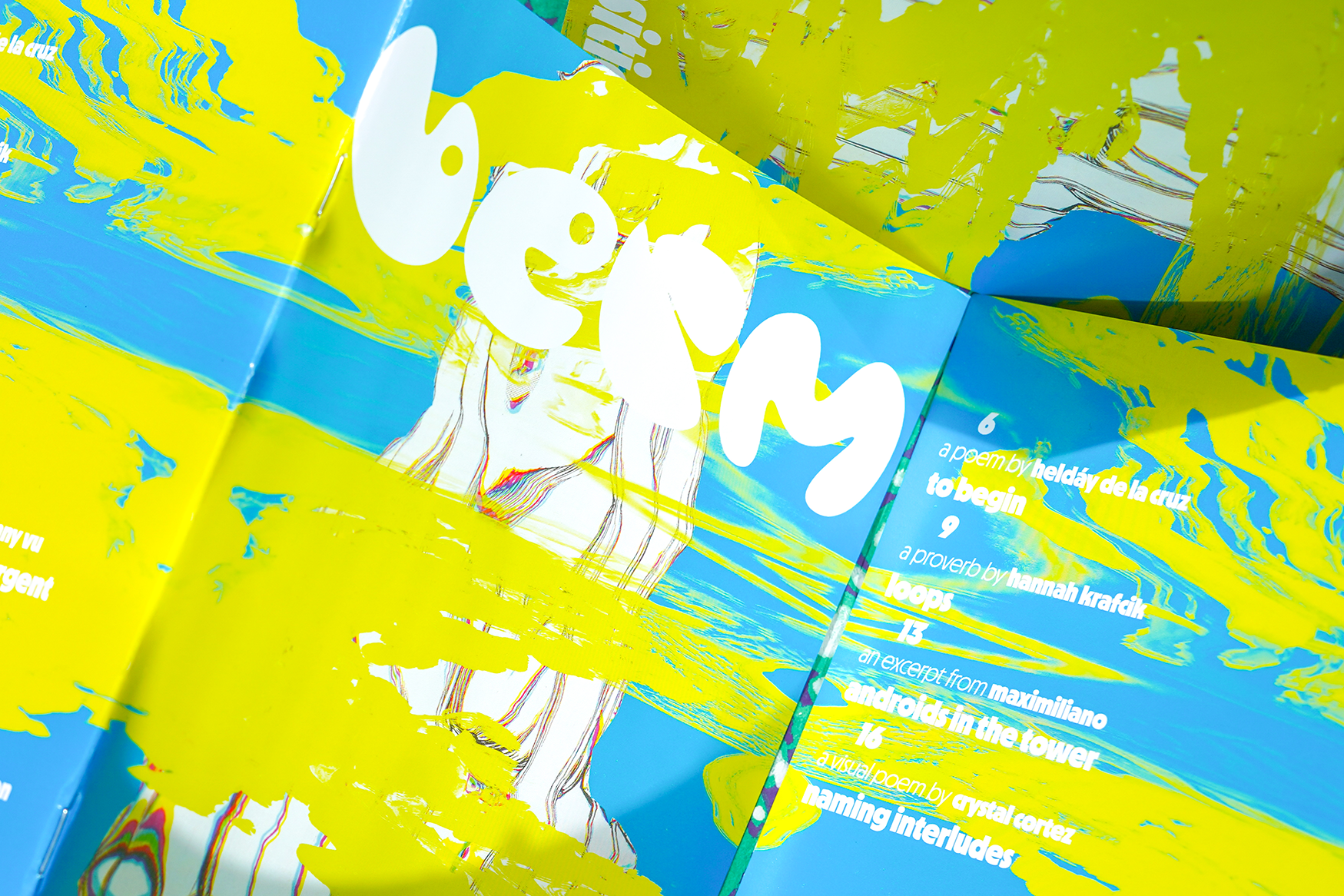In our debut issue, we asked for reflections on contemporary art with the theme of Transitions. Whether it be in work, gender, or location, transitions can be a huge aspect of a person's creative practice and life, and we're excited to share the work of seven writers and artists.

Reflections and Lessons from Issue One
Goals
Berm was conceived as a contemporary arts magazine, which was meant to sit on magazine shelves next to publications like JOON and Apartmento. The look, feel, and design principals would appeal to people who read similar design-focused magazines, but also serve to highlight creatives from diverse backgrounds and areas of art practice.
Berm was planned to be a quarterly magazine that would be supported by a combination of sales, grants, and sponsorships.
Through research and planning, the first issue would also serve as a guide for future issue timelines, budget, and quantity.
History
- The Notion project board was created on June 14th, 2021, which is when primary research began.
- In October of 2021, we set a list of potential contributors, the issue one theme, and created an early version of the budget.
- On October 22, 2021, the first pitch emails were sent to contributors.
- The final draft deadline was on February 17, 2022
- On March 28th, 2022 the printer informed us that printing was done!
- Berm Issue one was released on April 4, 2022.
Achievements
As planned, the issue was released as a 32-page 8.5 x 5.5 full color magazine at 100 copies, on April 4th, 2022.
A major goal was to pay all contributors before the issue was released, and ideally within 30 days of final acceptance. Despite a small delay in the bookkeeping process, this did happen! All contributors were paid in full before the issue was released.
The design and look of the magazine took up a significant portion of the research and development phase, and the final product is a reflection of not only those efforts, but of design principals we love and aim to achieve.
One week after initial release, there were only 35 copies remaining of the 100-issue print run.
Lessons
Raising money was hard and not something we had to do for previous projects. This presents a challenge that was, for us, unique. We hoped to achieve a quarterly release schedule, but were unable to secure the funds necessary in the lead up to the first issue to begin pitching the second issue. More research into pitching advertisers is needed, and a headstart on upcoming grant opportunities would relieve some of this pressure in the future.
While we did not get negative feedback from contributors about the production schedule or deadlines, we would like to make it more transparent for the second issue. When pitching starts, we want to have a page we can point to that clearly outlines when the milestones are and what we expect to receive at each deadline.
For paper, we'd like to make sure we're able to see and feel the paper we plan on using before we commit to it. The cover was stiffer than we would have liked, and the internal pages could have been a more booklike matte rather than a coated matte. This may have provided a more professional and less zine-like presentation.
For written pieces with a more experimental presentation, being able to collaborate with the author would help to alleviate issues in the design process that may lead to delays later in the timeline, and also insure the highest possible print quality.
Budget
The original budget was constructed to have a low, but reasonable cost for the amount we wanted to pay contributors and the quality of the magazine we were looking to produce. After a few drafts of the budget, this cost was set at $2,003.20.
The final total cost of the budget was $2,492.44, which was a $489.24 variance from estimations. Most of the additional cost can be accounted for in Shipping Cost, Packaging, and Marketing. There was a slight increase in the cost of paper from when we originally quoted printing, but it was not significant. A $50 quote licensing fee was not expected, but was decided to be necessary for one piece of writing.
Reflecting on the budget: We did pretty good! The additional marketing cost was not planned, but will be nice to have for pitching future issues to grant opportunities, contributors, and sponsors. While we were unable to pay W.A.G.E. minimums for the first issue, we are on track to come closer to those rates with our second issue budget. All contributors were paid, and all shipments were made in a timely manner without completely breaking the budget, which feels like an achievement.
Total Budget
Estimate: $2,003.20
Cost: $2,492.44
Variance: $489.24
Printing
Estimate: $658.00
Cost: $664.00
Variance: $6.00
Comment: Likely due to cost of paper
New Work Full 1
Estimate: $400.00
Cost: $400.00
Variance: $0.00
Existing Work
Estimate: $200.00
Cost: $200.00
Variance: $0.00
Small Writing 1
Estimate: $50.00
Cost: $50.00
Variance: $0.00
Small Writing 2
Estimate: $50.00
Cost: $50.00
Variance: $0.00
Medium Writing 1
Estimate: $100.00
Cost: $100.00
Variance: $0.00
Medium Writing 2
Estimate: $100.00
Cost: $100.00
Variance: $0.00
Large Writing 1
Estimate: $150.00
Cost: $150.00
Variance: $0.00
Quote Licensing
Estimate: $0.00
Cost: $50.00
Variance: $50.00
Zine Slips and Backers for Distribution
Estimate: $40.00
Cost: $59.75
Variance: $19.75
Shipping
Estimate: $255.20
Cost: $268.69
Variance: $13.49
Comment: Cost at media mail price of 3.19 * 80 = 255.2
Stickers
Estimate: $0.00
Cost: $100.00
Variance: $100.00
Comment: Not planned, but nice
Marketing Photography
Estimate: $0.00
Cost: $300.00
Variance: $300.00
Comment: Not planned, but nice